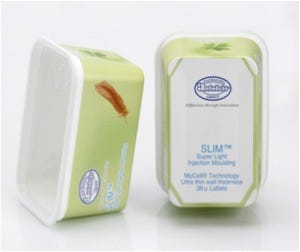MuCell from Trexel offers benefits for thin wall packaging applications
January 15, 2015
So you thought that MuCell microcellular foaming technology was only great for thick-walled parts. That’s not entirely true. MuCell foaming technology, which creates a microcellular material structure in plastic parts, holds a lot of benefits in thin-walled packaging applications as well.
 For over 20 years, Trexel has supplied MuCell foaming technology, which involves the introduction of Nitrogen or CO2 as the foaming agent in the supercritical state into the polymer in the plasticizing unit of an injection molding machine. Specifically within the packaging market, MuCell meets the growing demands and trends by providing molders benefits such as lower part costs due to lower material consumption and increased productivity and efficiencies; increased mold cavitation and thin walling by lowering cavity pressure in-mold labeling and the ability to achieve complex product designs.
For over 20 years, Trexel has supplied MuCell foaming technology, which involves the introduction of Nitrogen or CO2 as the foaming agent in the supercritical state into the polymer in the plasticizing unit of an injection molding machine. Specifically within the packaging market, MuCell meets the growing demands and trends by providing molders benefits such as lower part costs due to lower material consumption and increased productivity and efficiencies; increased mold cavitation and thin walling by lowering cavity pressure in-mold labeling and the ability to achieve complex product designs.
“Our customers have seen many marked process improvements by utilizing MuCell. From reduced clamp tonnage requirements to significant part weight reduction, our technology provides them a real cost advantage,” said Steve Braig, president and CEO of Trexel.
The new SLIM container is a good example of what can be achieved with MuCell and includes significant part weight reduction through reduced thickness of the base and sidewalls to 0.35mm which means 13% total less material by design and foaming; reduced clamp tonnage by 35% (4x4 stack molds can run on 350-ton machines instead of 500+ ton machines) and with higher cavitation for the same size machine. Molders can also achieve reduced injection pressure.
For more information and to see this unique packaging using MuCell technology, visit booth W-1523 at NPE.
You May Also Like


